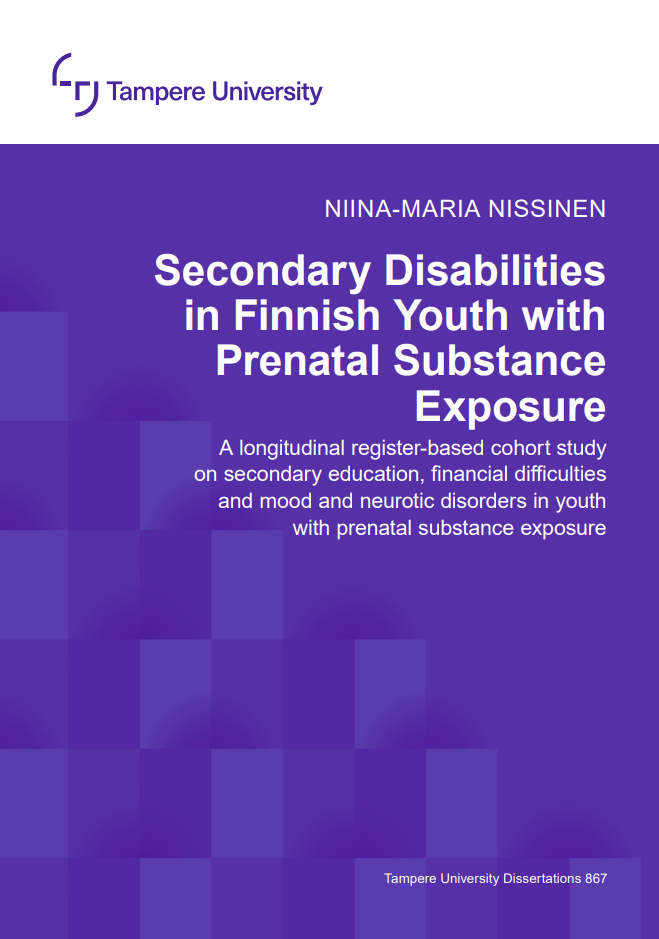Use of alcohol and/or illicit drugs during pregnancy and long-term consequences for child development
Alcohol, DrugsNiina-Maria Nissinen, PhD (health sciences) Published 14 Feb 2024
Consuming alcohol and/or illicit drugs when pregnant can have serious consequences on a wide range of issues for the child. In her doctoral dissertation, Niina-Maria Nissinen studied how Finnish youth exposed to maternal substance abuse during pregnancy were performing at the age of 18 to 24 years in terms of secondary education, financial self-supporting and mental health compared with youth without registered evidence of maternal substance use during pregnancy. In this article, Nissinen highlights some of the findings, and stresses the importance of preventive measures.
Results show that youth exposed to substances during pregnancy less often completed secondary education compared with unexposed youth (37.8 per cent of 283 exposed people vs. 51 per cent of 820 unexposed). In addition, the exposed youth were three times more often recipients of long-term financial social support compared with the unexposed peers. Exposed youth were slightly younger at the first long-term financial social assistance receipt, and they needed financial social support for longer time period compared with unexposed youth.
In terms of mood and neurotic disorders, the exposed youth were twice more often in specialized healthcare due to these disorders compared with the unexposed youth (20.9 per cent of 594 exposed people vs. 9.6 per cent of 1735 unexposed). Among both groups, the onset age of these disorders was between 14 to 16 years.
Overall, these results indicate that youth exposed to substances during pregnancy are a vulnerable population at high risk of experiencing challenges during the youth period – the rate being significantly higher compared with the unexposed youth or the general youth population. The studied adverse youth outcomes are also known risk factors for marginalization later in adulthood. Thus, early identification and prevention of these challenges and support is crucial to secure transition from childhood dependency to independent adulthood.
Mental/behavioral disorders two times more common among the exposed youth
The results regarding highly prevalent mental/behavioral disorders among the exposed youth were alarming. Mental/behavioral disorders were twice as common among the exposed youth compared with the unexposed peers, or the general youth population. These disorders also predicted the lack of secondary education and long-term financial social assistance needs.
Association between prenatal substance exposure and various mental/behavioral disorders on the internalizing (e.g., depression, anxiety) and externalizing continuum (e.g., ADHD and behavioral challenges) have been well-established in the research literature. However, the findings of the dissertation add to the research literature by showing that these disorders were linked with the adverse youth outcomes. Thus, early identification and prevention of these disorders would be crucial, also in terms of educational performance and financial self-supporting abilities.
Adverse childhood environment predicting the adverse youth outcomes
According to the findings, the childhood environment among the exposed youth was often characterized by an accumulation of maternal adversities describing maternal difficult life situation linked with substance use problems. These included single parenthood, low educational level, mental health disorders, financial difficulties, criminality and death of the mother. These maternal adversities may also be reflected as difficulties in the parenting behaviors and neglect in child’s care resulting as a high proportion (64 per cent) of the exposed youth being placed in out-of home care in early childhood compared with less than 10 per cent in the unexposed group.
The results add to the research literature by showing that the adverse maternal characteristics and out-of home care were important factors increasing the likelihood of financial social assistance needs and mood and neurotic disorders – the effect of these adversities on the youth outcomes outweighed the effect of prenatal substance exposure.
These findings highlight the need to understand how other risk factors associated with maternal substance abuse are associated with child long-term outcomes in the exposed populations.
Prevention requires action at different levels and among various professionals

To conclude, youth exposed to substances during pregnancy are a vulnerable population at high risk of challenges during the youth period. Nissinen highlights that the prevention of the adverse youth outcomes in the exposed populations requires actions at different levels. Prevention is important also from the societal perspective, as substance use during pregnancy and the associated consequences create a significant economic burden to societies.
The prevention requires training of various professionals including healthcare and educational professionals on the long-term effects of exposure to substances during pregnancy. Without the knowledge, many exposed individuals go unidentified, undiagnosed, or misdiagnosed, and thus, don’t necessarily receive the support and treatment for their needs. The prevention also requires individualized long-term support for the exposed individual and his/her family. This goes hand in hand with the identification and diagnosing the difficulties these individuals experience.
In addition, securing a safe and stable childhood environment is critically important considering the accumulation of adversities and care instability in the exposed populations, and the long-term effects these have on one’s development and wellbeing.
Prevention also requires shift in attitudes towards consumption of alcohol or any substance during pregnancy. There is no safe level of substances that can be consumed during pregnancy without harming the fetus. Therefore, a clear message recommending abstinence, already when planning pregnancy, should be emphasized.
The article is written by Niina-Maria Nissinen, PhD (health sciences).
on the request of PopNAD.


